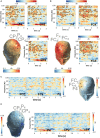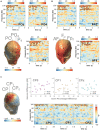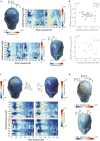Alpha/beta-gamma decoupling in methylphenidate medicated ADHD patients
- PMID: 37841679
- PMCID: PMC10570420
- DOI: 10.3389/fnins.2023.1267901
Alpha/beta-gamma decoupling in methylphenidate medicated ADHD patients
Abstract
There is much interest to understand how different neural rhythms function, interact and are regulated. Here, we focus on WM delay gamma to investigate its coupling with alpha/beta rhythms and its neuromodulation by methylphenidate. We address this through the use of human EEG conducted in healthy and ADHD subjects which revealed ADHD-specific electrophysiological deficits and MPH-induced normalization of gamma amplitude and its coupling with alpha/beta rhythms. Decreased alpha/beta-gamma coupling is known to facilitate memory representations via disinhibition of gamma ensembles coding the maintained stimuli. Here, we present EEG evidence which suggests that these dynamics are sensitive to catecholaminergic neuromodulation. MPH decreased alpha/beta-gamma coupling and this was related to the increase in delay-relevant gamma activity evoked by the same drug. These results add further to the neuromodulatory findings that reflect an electrophysiological dimension to the well-known link between WM delay and catecholaminergic transmission.
Keywords: ADHD; EEG; coupling; methylphenidate; neural oscillations; working memory.
Copyright © 2023 Zammit and Muscat.
Conflict of interest statement
The authors declare that the research was conducted in the absence of any commercial or financial relationships that could be construed as a potential conflict of interest.
Figures





Similar articles
-
Beta band oscillatory deficits during working memory encoding in adolescents with attention-deficit hyperactive disorder.Eur J Neurosci. 2019 Sep;50(5):2905-2920. doi: 10.1111/ejn.14398. Epub 2019 Apr 1. Eur J Neurosci. 2019. PMID: 30825351
-
Methylphenidate does not improve interference control during a working memory task in young patients with attention-deficit hyperactivity disorder.Brain Res. 2011 May 4;1388:56-68. doi: 10.1016/j.brainres.2011.02.075. Epub 2011 Mar 5. Brain Res. 2011. PMID: 21385569
-
Exploration of electroencephalogram response to MPH treatment in ADHD patients.Psychiatry Res Neuroimaging. 2023 Jul;332:111631. doi: 10.1016/j.pscychresns.2023.111631. Epub 2023 Mar 24. Psychiatry Res Neuroimaging. 2023. PMID: 37030146
-
Working Memory and Cross-Frequency Coupling of Neuronal Oscillations.Front Psychol. 2021 Oct 21;12:756661. doi: 10.3389/fpsyg.2021.756661. eCollection 2021. Front Psychol. 2021. PMID: 34744934 Free PMC article. Review.
-
Working memory and neural oscillations: α-γ versus θ-γ codes for distinct WM information?Trends Cogn Sci. 2014 Jan;18(1):16-25. doi: 10.1016/j.tics.2013.10.010. Epub 2013 Nov 19. Trends Cogn Sci. 2014. PMID: 24268290 Review.
References
-
- American Psychiatric Association . Diagnostic and statistical manual of mental disorders [DSM-V] 5 Arlington, VA: American Psychiatric Publishing, (2013).
-
- Arnsten A. F. T. (2006). Fundamentals of attention-deficit/hyperactivity disorder: circuits and pathways. J. Clin. Psychiatry 67, 7–12. PMID: - PubMed
LinkOut - more resources
Full Text Sources

